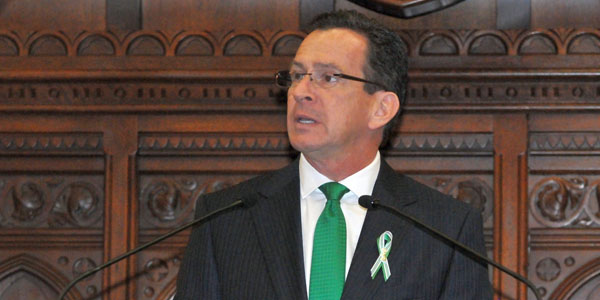
Amid the Newtown tragedy fallout and national discussions on gun policy, jobs remains the priority, Gov. Dannel P. Malloy said in his State of the State address Jan. 9.
“Until every person in our state who wants a job can find one, we have more work to do,” he said, ringing in the new legislative session. “We can”™t stick our heads in the sand or simply hope for the best.”
“We must compete for every single job,” he said.
Addressing the state”™s progress over the last two years when it comes to job creation, energy, education and the state”™s budget deficit, Malloy said the state is off to a strong start, but it”™s only the start.
“We have a great deal of work to do,” Malloy said. “But if history is any judge, we will rise to the occasion.”
As Malloy detailed his policy goals, the Connecticut Business & Industry Association (CBIA) laid out its 2013 legislative agenda. The organization calls for reduced government spending as a means of addressing the projected deficit for the 2014-2015 fiscal years.
“The key issue going into this session is the state budget,” said Joe Brennan, CBIA senior vice president of public policy. “We feel really strongly that the state has to reduce spending, be more efficient and set priorities. If that can be done ”” if they can show they”™re really changing””we think that can be a really great economic development tool.”
Current estimates project at least a $2 billion budget deficit for the 2014-2015 biennium, primarily due to increased Medicaid use and program changes. And while Malloy puts together his budget proposal due to the legislature in February, CBIA officials say they hope it does not include any new taxes.
According to CBIA data, state government spending has increased 153 percent since 1992, outpacing inflation, population and the median income growth. Two years ago the state saw its biggest increase ever in taxes and now it”™s time to cut back on spending, Brennan said.
“By continuing to have these (tax) increases, it sends the message that we”™re not the best place to invest in growth,” Brennan said. “Other states have been able to grow while we haven”™t.”
Malloy mentioned little of the state”™s budget challenges in his State of the State address, other than to say the state had more tough choices to make in the future and that it has already made large gains in getting its fiscal house in order.
“Anyone who tells you that the budget we passed two years ago didn”™t do its job, that it didn”™t make real change in how we approach our finances, is simply not telling the truth,” Malloy said. “We”™ve all had to buckle down and make tough choices. We”™re going to make more of them in the weeks and months ahead.”
To reduce state spending, CBIA”™s key recommendations included adaption of lean and other efficiency strategies, expanded use of shared municipal services and upgrades to the state”™s information technology to facilitate better coordination. Additionally, the organization recommended the state begin to encourage more home-based elder care to relieve nursing home costs and further negotiation be made to reduce the cost of state employee retiree health care and pension benefits.
“Legislators are looking for ideas,” Brennan said. “During the last couple years, businesses have been forced to reduce the cost of their operations and they”™re very thoughtful in how they do that.”
“Hopefully (our recommendations) will receive a full review this year,” he said.
In addition to CBIA”™s recommendations for a “more sustainable” state government, the group also listed a number of ways to reduce the cost of doing business in the state. For instance, the group contends energy costs could be reduced by having a more diverse portfolio of energy sources and by eliminating taxes on energy transmission and generation. Additionally, the group says health care costs could be cut by reducing current health care mandates and rejecting future ones.
“It”™s going to be a challenge, there”™s no doubt about that,” Brennan said. “But with some hard work and creative thinking, we think we can solve this budget gap without an increase in taxes.”
A version of this article appeared in the print edition of the Business Journal for the week of Jan. 21, 2013.





















Comments 1